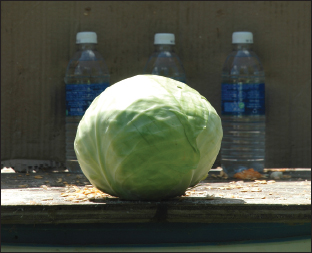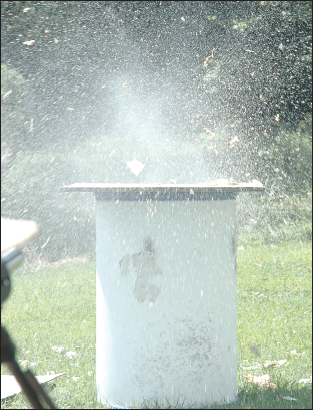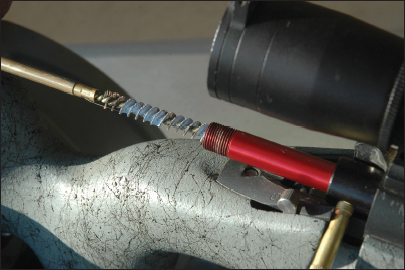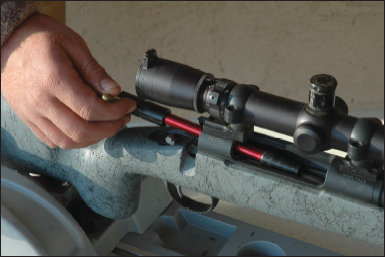14. Opening the Throttle
Jacketed bullets became necessary in the 1890s to withstand the higher velocities generated by smokeless powders. The jackets were of steel with a cupro-nickel coating. Satisfactory in the.30-40 Krag, they fouled badly at the higher velocities of the .30-06. Tiny lumps of jacket adhering to the relatively cool steel near a rifle’s muzzle tore at the jackets of other bullets, accelerating the process. Shooters fought the fouling with “ammonia dope,” a solution of.5 oz. ammonia bicarbonate, 1 oz. ammonia sulfate, 6 oz. ammonia water, and 4 oz. tap water. Poured into a plugged barrel and allowed to “work” for 20 minutes, this brew was then flushed out with hot water. Drying and oiling followed. Riflemen took care not to spill the ammonia, which could pit exposed metal.
To reduce metal fouling, the US Army issued “Mobilubricant” to soldiers on the eve of World War I. Unexpectedly, pressures in the .30-06 began bouncing from 51,000 to around 58,000 PSI. Coating cartridges with Mobilubricant sent pressures higher still. A lubricated case gave the neck no room to expand while it increased back-thrust on the bolt. This problem was exacerbated by tin-plated jackets. Tin sometimes “cold soldered” itself to the case neck. One bullet recovered at a shooting range still wore the case neck! The Army soon dropped Mobilubricant and tin-plated bullets, choosing instead to incorporate tin in the jacket alloy. Later cupro-nickel (60 percent copper, 40 percent nickel) became the jacket of choice. Gilding metal (90 percent copper, 10 percent zinc) was initially thought to be too soft for the high-speed 150-grain bullet in.30-06 service ammunition; but Western Cartridge Company’s jacket of 90 percent copper, 8 percent zinc and 2 percent tin worked well. It was called Lubaloy. In 1922 Western provided Palma Match ammunition with 180-grain Lubaloy-coated bullets. That year, experiments at Frankfort Arsenal showed that gilding metal could stand up to high velocities. It remains a popular jacket material for hunting and target bullets. Most bullet-makers now favor jackets comprising 95 percent copper and 5 percent zinc (though Nosler stayed with a 90-10 alloy for its Partition bullets turned on screw machines before 1970). Softer, almost pure-copper jackets began showing up on bullets designed for deep penetration—like the Bitterroot Bonded Core, one of the first so-called “controlled expansion” bullets. Ductile jackets are less likely to break apart on contact with heavy muscle and bone. The liability of pure copper is its tendency to foul barrels.
The lead cores of big game bullets have a dash of antimony to make them harder. The usual ratio is 97.5 percent lead, 2.5 percent antimony. A little antimony makes a big difference; 6 percent is about the limit in hunting bullets. Sierra uses three alloys for rifle bullets, with antimony proportions of 1.5, 3, and 6 percent. A few game bullets have been described as having pure lead cores. Thick copper jackets on these bullets keep soft cores from disintegrating on impact. “Pure,” incidentally, means unalloyed. But even pure bullet lead has traces of copper, zinc, nickel, arsenic, and aluminum. As little as .1 percent copper can cause hard spots. Cores are commonly cut from lead wire, extruded from bar stock in the appropriate diameter, then annealed to prevent expansion during forming.
Bullet jackets come about in one of two ways: “cup and draw” or impact extrusion. Drawn jackets begin as wafers punched from sheet metal. Formed over a series of dies, they become progressively deeper cups that are eventually trimmed to length and stuffed with lead. The bullet is then shaped and finished off at the nose. Jackets given the impact extrusion treatment begin as sections of metal rods that are annealed and fed into a punch press, which slams them into cups with 60 tons of force. Bullets like Nosler’s Partition have cavities fore and aft so they must be punched twice. Nosler claims its current extruded jackets yield better accuracy than those on the original Partitions which were machine-turned and when completed had a hole in the dam of jacket material. The hole varied in location and hardly contributed to tight groups.
Cannelures help the jacket grip the core but serve mainly as crimping grooves. Cannelures have gradually disappeared on rifle bullets. They have been retained on bullets for heavy-recoiling rounds like the.458 Winchester (the crimp to prevent bullet creep in the magazine) and on pistol bullets (the crimp to keep short bullets with little case contact in place and smooth the cartridge profile for better feeding). Hornady, Winchester, and a few other makers routinely crimp bullets. Most cannelures are rolled on, but Nosler cuts the groove in its 210-grain .338 bullet. Claims that crimping impairs accuracy have not been substantiated.

While it leaves no channel to measure, a cabbage can show the destructive power of a softpoint.
Jacket and core dimensions must be held to tight tolerances for top accuracy. Sierra, renowned for match-winning target bullets, keeps jacket thickness within .0003 of a standard. The company limits bullet weight variation to .3-grain. Test lots of 168-grain 30-caliber match bullets that don’t shoot into .250 inch at 100 yards can disqualify the entire batch.
Strict quality control has maintained Hornady’s reputation for accuracy. “We shoot four five-shot groups to check lots,” I was told on a factory visit. “The average must meet tough standards. For .30s it’s .600 at 100 yards, for 6mms it’s .450, for .17s it’s .400.” Match bullets face a high bar indeed. “We demand .350 from .22s. Our 30-caliber match bullets must stay inside .800 at 200 yards.” Targets with their centers chewed out hang at each production station, proof of standards met.
Bullets from Walt Berger’s shop, renowned among bench-rest shooters, have brought match-level accuracy into the hunting field. Nosler has grown its line the other way—from top-grade hunting bullets to boat-tail hollow points designed expressly to drill one-hole groups.
Demands on hunting bullets regarding dimensional uniformity are less stringent than on bullets for target shooting. Expansion, penetration, and weight retention usually matter more than gnat’s-eye precision. An expanding bullet releases energy as it decelerates. Flattening, the nose does not slide through as would the sleek ogive of a jacketed bullet failing to open. It pushes, boosting deceleration rate and energy release. Its rotating nose petals tear tissue. Comparing channels made by a bullet that did not upset and one that opened to double diameter, you’ll find the cross-sectional areas differ dramatically. The relationship is not 1:2—expanding bullets are much more destructive. Ragged petal edges, plus the hydraulic effect caused by displaced tissue, increase damage.
Securing jacket to core is crucial if a bullet is to maintain its integrity in heavy bone and muscle. Core-Lokt, Trophy Bonded, Bonded Core, Hot-Core, and AccuBond are trade names that play on this theme of bullet integrity. Remington’s Core-Lokt has an inner belt (from the Peters Inner Belted bullet, progeny of the Peters Belted, with its exterior metal girdle). The Speer Hot-Core process ensures adhesion because the lead is warm enough to snuggle into every void in the jacket. These days, chemical bonds have boosted retained weight above the 90-percent mark for many game bullets. Bonding is simply a way to keep jacket and core from separating under the tremendous stresses induced by high-speed bullet impact. John Nosler sought a mechanical solution in 1947, after bullets from his .300 Magnum disintegrated on a moose. His Partition bullet featured a wall of jacket material that divided the core. No matter how violent the forces tearing at the bullet nose, the heel core remained captive. It penetrated like a solid bullet, ensuring a long wound channel. The Partition remains hugely popular. Swift’s A-Frame combines Nosler’s Partition design with nose bonding that all but prevents core-jacket separation up front.

A Winchester .223 takes a cabbage apart. The Ballistic Silvertip lead-free bullet pulps all!

A rifleman starts a brush in a bore guide. For large bores, attach the brush in front of the guide.
Incidentally, John Nosler wasn’t the first engineer to employ a mechanical device to control upset. Before the Great Depression, American entrepreneur Charles Newton developed a wire-core bullet. During the 1940s the German H-Mantle bullet appeared, with a central dam much like Nosler’s. A half-century later, Winchester took this idea to another level with its Fail Safe bullet. Now discontinued, it had a hollow nose of copper alloy, notched to deliver uniform four-petal upset. A steel heel cup was inserted after a few months’ production to keep the lead core from ballooning the midsection and escaping jackets ruptured by the petal tips. Weight retention of Fail Safes typically approached 100 percent with pass-through penetration. A modified Partition, called the Partition Gold, was marketed by Winchester recently. Developed under the “Combined Technology” banner that marked collaboration between Winchester and Nosler, Partition Gold dams were moved forward to increase retained weight if the nose disintegrated. A steel heel cup prevented deformation of the rear jacket. Like the Fail Safe, the Partition Gold wore a black oxide finish.

One bore guide will serve for almost all the bolt rifles you’ll likely encounter.
Bullet nose design has a lot to do with how expansion proceeds. Hollow point bullets are typically used for target shooting and on thin-skinned animals. Small cavities and thicker jackets keep hollow points from breaking up on big game, but they also make expansion less dependable. Among early hollow points, the Western Tool and Copper Works bullet with a tiny nose cavity had perhaps the best reputation among hunters. Westley-Richards offered a bullet with a dimple covered by a metal cap that protected the nose and kept the jacket from rupturing prematurely. DWM’s “strong-jacket” bullet had a long, narrow nose cavity lined with copper tubing and capped.
As new cartridges hiked muzzle velocities, the task confronting bullet designers got more difficult.
Game bullets had to withstand higher impact speeds; at the same time, hunters still expected them to open at modest velocities far from the muzzle. In the early days of smokeless cartridges, iron sights limited shot distances to a couple of hundred yards. So the velocity window in which game bullets had to perform well was relatively narrow. Most bullets left the muzzle clocking from 2,100 to 2,700 fps and reached 200 yards at 1,400 to 2,100 fps. A .300 magnum with a scope might now be used to clobber an elk at 50 steps, where the bullet is rocketing along at 3,200 fps, and then turned on a pronghorn at 500 yards, where velocity has dropped off to 2,000. The heavy shoulder of an elk exacerbates the tendency of a high-speed bullet to come apart, while the fragile pronghorn may not present enough resistance for a stout bullet, slowed by distance, to expand at all. Various solutions have been developed to ensure upset with penetration across a spectrum of impact speeds, on targets of varying resistance.

Winchester’s M 71 was dropped in 1957. Browning’s recent, elegant copy is now discontinued.
Table of contents
- Title Page
- Dedication
- Copyright
- Acknowledgments
- Foreword
- CONTENTS
- INTRODUCTION
- SECTION I: BALLISTICS IN HISTORY
- SECTION II: THE MUSCLE BEHIND THE SHOT
- SECTION III: BULLETS—THE INSIDE STORY
- SECTION IV: SPEED, ENERGY, AND ARC
- SECTION V : PUTTING BALLISTICS TO WORK
- SECTION VI: FOR LONGER REACH
- BALLISTICS TABLES FOR MODERN SPORTING RIFLES
- GLOSSARY